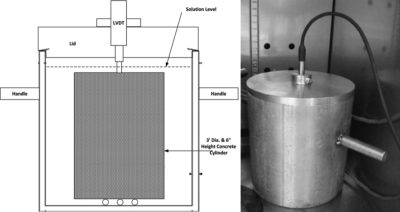
Alkali–silica reactions (ASRs) cause cracking issues in precast concrete bridge structures across the United States. Anol Mukhopadhyay, Texas A&M Transportation Institute (TTI) senior research scientist, developed two ASR test methods and a four-step process for formulating ASR-resistant concrete mixes. Mukhopadhyay notes that TTI Assistant Research Scientist Kai-Wei (Victor) Liu’s collaboration in the lab was key to the development of these test methods. Mukhopadhyay manages TTI’s Rigid Pavements Program and supervises the Concrete Innovation Lab in the Center for Infrastructure Renewal on The Texas A&M University System’s RELLIS Campus. He is nationally and internationally recognized as a concrete durability expert.

The first ASR test method, volumetric change measuring device (VCMD), is listed by the American Association of State Highway and Transportation Officials (AASHTO) as Standard Method of Test for Determination of Composite Activation Energy of Aggregates due to Alkali–Silica Reaction (Chemical Method) (AASHTO T 364). First published in 2017 by AASHTO, the ASR test method measures how an aggregate — similar in makeup to portland cement concrete — reacts with a simulated pore solution. The VCMD-based method is a quick, reliable ASR test method, predicting aggregate reactivity in terms of measuring the compound activation parameter (CAP) within five days.

AASHTO approved the second ASR test method, accelerated concrete cylinder testing (ACCT), as a standard and will publish it online in July. The method validates concrete mixes by providing further ASR-resistant testing. Mukhopadhyay applied the ACCT-based method to fly ash — a coal combustion product — and found that the ASR test method performs similarly fast, reliable tests on reactivity like the VCMD-based method.

“Developing the test methods and seeing them accepted as AASHTO standards were rewarding for me and my team. AASHTO’s recognition enables the methods to reach a wider audience of concrete mix producers and owners, who can follow the steps to create their own ASR-resistant mixtures,” says Mukhopadhyay. “Having easy access to ASR test methods can help support the construction and longevity of bridges by making long-lasting, durable concrete, reducing costs for repair and maintenance, and ensuring safety for travelers.”
Combining both methods resulted in the development of a four-step mix process to reduce ASR’s impact on concrete in bridges. The process is flexible enough to allow concrete mix staff to change the mix design depending on their specific needs. The steps are as follows:
- Step 1: Determine CAP (a measure of aggregate reactivity) and the aggregate threshold alkalinity (THA) by the VCMD method. A standard relationship between reactivity and THA has been developed based on several aggregate tests, which can be used to assign THA for an aggregate with known reactivity.
- Step 2: Select suitable mix design controls depending on the aggregate reactivity and THA, then estimate the concrete pore solution alkalinity (PSA). Mukhopadhyay and Pravin Saraswatula, a TTI engineering graduate student worker, developed an easy-to-use tool to estimate PSA.
- Step 3: Make a mix design adjustment (if needed) based on the THA–PSA relationship. PSA needs to be below THA to mitigate ASR.
- Step 4: Conduct mix design validation using the ACCT method. The expansion of the tested concrete cylinder should be ≤ 0.04 percent.
A leader on ASR-resistant concrete, Mukhopadhyay coauthored the technical paper “An Innovative Approach to Fly Ash Characterization and Evaluation to Prevent Alkali–Silica Reaction” in the July 2019 issue (vol. 116, no. 4) of the American Concrete Institute’s (ACI’s) ACI Materials Journal. He connected with an international audience in the article “Innovative Approach for Formulating ASR-Resistant Mixtures” in the December 2018 issue of ACI’s Concrete International, a magazine for the international concrete community.
“AASHTO materials standards are recognized as having been vetted by experts in the state departments of transportation — with academia and industry involvement — to provide materials protocols that transportation agencies can adopt confidently,” says Georgene Geary, a retired materials engineer, a current consultant for AASHTO and a former vice chair of the AASHTO Materials Committee.